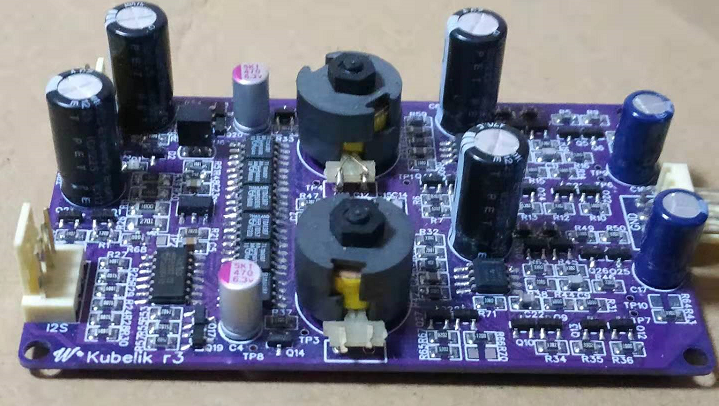My first incarnation of the 'Kubelik' design, using the architecture I set out in the previous post used a single TDA1387 DAC chip. Listening to this, it turned out to have a very engaging improvement in transparency over 'PhiDAC' - there was that sense of 'air' or 'bloom' which created an impression of an acoustic bubble between and behind the speakers. However while the HF was very good, overall I felt the sound was too unbalanced top-to-bottom, there wasn't sufficient 'presence' in the bass, a lack of spaciousness at the lowest frequencies which help depict the acoustic signature of a hall or recording studio. The overall effect is the presentation sounds a little thin.
Increasing the number of chips to 3 did bring about improvement at the low end but it wasn't until I reached 6 chips that I felt there was a balance top-to-bottom, no more thinness. Going to more chips than six wasn't practical for a couple of reasons - there wasn't sufficient PCB space within the original confines of PhiDAC and also the dropping resistors (from 20V down to ~5V) couldn't be accommodated. In the end, thermal constraints restricted the DAC's supply voltage to 4.5V. Paralleling chips improves the signal-to-noise by 3dB for each doubling, so with 6 chips we have almost 8dB lowering of the noise and this reduced noise floor is most apparent in the bass. I'm guessing this bass-lightness of a stand-alone chip stems from it being CMOS where 1/f noise corners are rather notoriously high.

I have a BOM, schematic and gerbers which I'll upload in due course. They're already available on the DIYA thread but its a long one to navigate. Kits may be ordered too.
Listening to Kubelik in comparison to DecaDAC, the latter sounds distinctly blurry in the higher frequencies relative to Kubelik, however it does have the edge in bass performance. Whether that's down to lower noise opamps or a lower noise DAC PSU remains to be seen.
 Richard Dudley
Richard Dudley
Discussions
Become a Hackaday.io Member
Create an account to leave a comment. Already have an account? Log In.
Found it! DIY Audio.
Are you sure? yes | no
Interesting project. Just joined today, so still learning how to navigate. But where is the DIYA thread?
Are you sure? yes | no